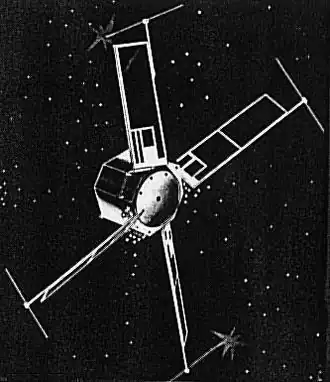Transit 5E-1
 Transit 5E-1 | |
| Mission type | Charged particle research Magnetospheric Solar research Geodesy |
|---|---|
| Operator | US Air Force |
| COSPAR ID | 1963-038C |
| SATCAT no. | 00671 |
| Mission duration | 11 years |
| Spacecraft properties | |
| Launch mass | 59 kilograms (130 lb) |
| Dimensions | 0.46 m x 0.25 m |
| Start of mission | |
| Launch date | 28 September 1963, 20:22 UTC |
| Rocket | Thor DSV-2A Ablestar |
| Launch site | Vandenberg LC-75-1-1 |
| Orbital parameters | |
| Reference system | Geocentric |
| Semi-major axis | 7,470.7 kilometers (4,642.1 mi) |
| Perigee altitude | 1,070.9 kilometers (665.4 mi) |
| Apogee altitude | 1,128.5 kilometers (701.2 mi) |
| Inclination | 90.1 degrees |
| Period | 107.1 minutes |
Transit 5E-1, International Designator 1963-038C, is an artificial satellite of the United States Department of Defense and launched on September 28, 1963, aboard a Thor rocket from the Vandenberg Air Force Base.[1]
Launch
Transit 5E-1 was launched to study charged particles, magnetic fields and solar spectra, as well as for geodetic research.[2]
It was launched to a polar orbit, from where it did geomagnetic and geodetic measurements. Electrical power was produced by four solar panels.[2] After August 1969, the satellite did measurements infrequently. The last data were transmitted in November, 1974.[3]
See also
References
- ^ "Vandenberg SLC2E (launch on 28 September 1963)". astronautix.com. Retrieved April 2, 2023.
- ^ a b Krebs, Gunter D. "Transit-5E 1 (S/N 39)"". Gunter's Space Page. Retrieved April 2, 2023.
- ^ "1963-038C (Transit 5E1)". NASA. Retrieved April 2, 2023.
External links